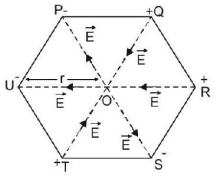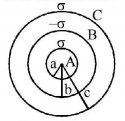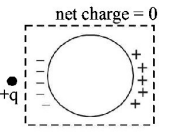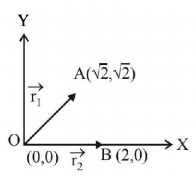1.
Two charge $$q$$ and $$-3q$$ are placed fixed on $$x$$-axis separated by distance $$d.$$ Where should a third charge $$2q$$ be placed such that it will not experience any force?

A.
$$\frac{{d - \sqrt 2 d}}{2}$$
B.
$$\frac{{d + \sqrt 3 d}}{2}$$
C.
$$\frac{{d + 3d}}{2}$$
D.
$$\frac{{d - \sqrt 5 d}}{2}$$
Answer :
$$\frac{{d + \sqrt 3 d}}{2}$$
2.
An electron is moving round the nucleus of a hydrogen atom in a circular orbit of radius $$r.$$ The coulomb force $$F$$ between the two is
(where, $$k = \frac{1}{{4\pi {\varepsilon _0}}}$$ )
A.
$$k\frac{{{e^2}}}{{{r^3}}}r$$
B.
$$ - k\frac{{{e^2}}}{{{r^3}}}r$$
C.
$$k\frac{{{e^2}}}{{{r^3}}}\hat r$$
D.
$$ - k\frac{{{e^2}}}{{{r^3}}}\hat r$$
Answer :
$$ - k\frac{{{e^2}}}{{{r^3}}}r$$
3.
Six charges of equal magnitude, 3 positive and 3 negative are to be placed on $$PQRSTU$$ corners of a regular hexagon, such that field at the centre is double that of what it would have been if only one $$+ve$$ charge is placed at $$R.$$ Which of the following arrangement of charge is possible for $$P,Q,R,S,T$$ and $$U$$ respectively.
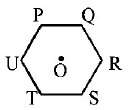
A.
$$+,+,+,-,-,-$$
B.
$$-,+,+,+,-,-$$
C.
$$-,+,+,-,+,-$$
D.
$$+,-,+,-,+,-$$
Answer :
$$-,+,+,-,+,-$$
4. Three concentric metal shells $$A,B$$ and $$C$$ of respective radii $$a,b$$ and $$c\left( {a < b < c} \right)$$ have surface charge densities $$ + \sigma , - \sigma $$ and $$ + \sigma $$ respectively. The potential of shell $$B$$ is:
A.
$$\frac{\sigma }{{{ \in _0}}}\left[ {\frac{{{a^2} - {b^2}}}{a} + c} \right]$$
B.
$$\frac{\sigma }{{{ \in _0}}}\left[ {\frac{{{a^2} - {b^2}}}{b} + c} \right]$$
C.
$$\frac{\sigma }{{{ \in _0}}}\left[ {\frac{{{b^2} - {c^2}}}{b} + a} \right]$$
D.
$$\frac{\sigma }{{{ \in _0}}}\left[ {\frac{{{b^2} - {c^2}}}{c} + a} \right]$$
Answer :
$$\frac{\sigma }{{{ \in _0}}}\left[ {\frac{{{a^2} - {b^2}}}{b} + c} \right]$$
5.
A charge $$Q$$ is uniformly distributed over a long rod $$AB$$ of length $$L$$ as shown in the figure. The electric potential at the point $$O$$ lying at distance $$L$$ from the end $$A$$ is

A.
$$\frac{Q}{{8\pi {\varepsilon _0}L}}$$
B.
$$\frac{{3Q}}{{4\pi {\varepsilon _0}L}}$$
C.
$$\frac{Q}{{4\pi {\varepsilon _0}L\ln 2}}$$
D.
$$\frac{{Q\ln 2}}{{4\pi {\varepsilon _0}L}}s$$
Answer :
$$\frac{{Q\ln 2}}{{4\pi {\varepsilon _0}L}}s$$
6. Three charges $$ + Q,q, + Q$$ are placed respectively, at distance, $$\frac{d}{2}$$ and $$d$$ from the origin, on the $$x$$-axis. If the net force experienced by $$ + Q,$$ placed at $$x = 0,$$ is zero, then value of $$q$$ is:
A.
$$ - \frac{Q}{4}$$
B.
$$ + \frac{Q}{2}$$
C.
$$ + \frac{Q}{4}$$
D.
$$ - \frac{Q}{2}$$
Answer :
$$ - \frac{Q}{4}$$
7.
Three charges $$ - {q_1}, + {q_2}$$ and $$ - {q_3}$$ are place as shown in the figure. The $$x$$-component of the force on $$ - {q_1}$$ is proportional to
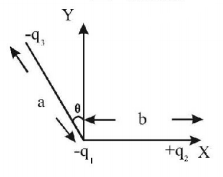
A.
$$\frac{{{q_2}}}{{{b^2}}} - \frac{{{q_3}}}{{{a^2}}}\cos \theta $$
B.
$$\frac{{{q_2}}}{{{b^2}}} + \frac{{{q_3}}}{{{a^2}}}\sin \theta $$
C.
$$\frac{{{q_2}}}{{{b^2}}} + \frac{{{q_3}}}{{{a^2}}}\cos \theta $$
D.
$$\frac{{{q_2}}}{{{b^2}}} - \frac{{{q_3}}}{{{a^2}}}\sin \theta $$
Answer :
$$\frac{{{q_2}}}{{{b^2}}} + \frac{{{q_3}}}{{{a^2}}}\sin \theta $$
8. A uniformly charged conducting sphere of $$4.4\,m$$ diameter has a surface charge density of $$60\,\mu C\,{m^{ - 2}}.$$ The charge on the sphere is
A.
$$7.3 \times {10^{ - 3}}C$$
B.
$$3.7 \times {10^{ - 6}}C$$
C.
$$7.3 \times {10^{ - 6}}C$$
D.
$$3.7 \times {10^{ - 3}}C$$
Answer :
$$3.7 \times {10^{ - 3}}C$$
9. Consider a neutral conducting sphere. A positive point charge is placed outside the sphere. The net charge on the sphere is then
A.
negative and distributed uniformly over the surface of the sphere
B.
negative and appears only at the point on the sphere closest to the point charge
C.
negative and distributed non-uniformly over the entire surface of the sphere
D.
zero
Answer :
zero
10. An electric charge $${10^{ - 3}}\mu C$$ is placed at the origin (0, 0) of $$X - Y$$ co-ordinate system. Two points $$A$$ and $$B$$ are situated at $$\left( {\sqrt 2 ,\sqrt 2 } \right)$$ and (2, 0) respectively. The potential difference between the points $$A$$ and $$B$$ will be
A.
$$4.5\,volts$$
B.
$$9\,volts$$
C.
Zero
D.
$$2\,volt$$
Answer :
Zero

